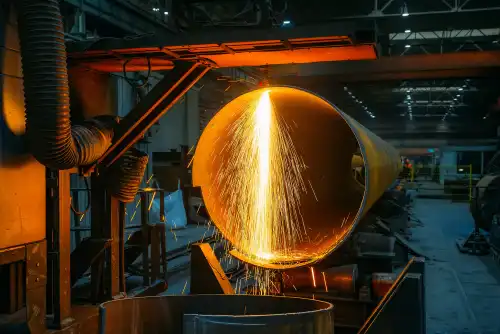The Heat treatment process of titanium alloys
Heat treatment is often required during the processing of titanium alloys. Common heat treatment of titanium alloys includes stress relief annealing, complete annealing, solution treatment, and aging treatment.

1. Stress relief annealing
Its purpose is mainly to eliminate the internal stress generated during cold processing, cold deformation, and welding. The stress relief annealing process is mostly used after hot forging, casting, cold deformation processing, cutting, cutting, welding, and other processes. The selection of annealing temperature and time is more important for stress relief annealing. For the heat treatment of titanium alloys, recrystallization temperature annealing is used to remove stress by recovery.
2. Complete annealing
Its purpose is to obtain recrystallized structure and improve material plasticity, so it is also called recrystallization annealing. Most α titanium alloys and α+β dual-phase titanium alloys are used in the fully annealed state.
For α titanium alloys, the annealing temperature is usually 120-200℃ below the phase transition point. Too high a temperature will coarsen the grains, while too low a temperature will cause incomplete recrystallization and insufficient plasticity. Since the cooling rate has little effect on the structure and properties of α titanium alloy, air cooling is often used.
For near-α titanium alloy and α+β dual-phase titanium alloy, in addition to recrystallization, there are also changes in α phase and β phase during the annealing process, so it is more complicated to determine the annealing temperature and cooling method.
For metastable β titanium alloy, full annealing is usually a solid solution treatment of the material, and the annealing temperature is generally 80-100℃ above the α+β/β phase transformation point.
3. Solution treatment and aging treatment
The purpose of solution treatment is to obtain metastable phases that can be strengthened by aging, such as α′ martensite, α″ martensite, or metastable β phase. The fine equilibrium phases produced by the decomposition of the metastable phases are used to produce precipitation-strengthening effects to improve the hardness and strength of the material. The solution temperature is usually 40-100°C lower than the α+β/β phase transformation point, and the primary α phase and β phase can be obtained to avoid excessive coarsening of the β grains. There are usually two types of cooling after solution treatment: water quenching and oil quenching, with water quenching being more common. Aging strengthening has a more obvious effect in the heat treatment of titanium alloys with high β stabilizing element content, but it is more effective in near-α alloys and α+β two-phase titanium alloys with low β stabilizing element content. In the case of titanium alloy, the aging strengthening effect is weak.
Changes in the heat treatment structure of titanium alloy
1. Changes in the structure during the heating process The crystal form of the heat treatment of titanium alloys heating process usually changes, and the α phase and β phase change, while the cold deformed titanium alloy will also recover and recrystallize.
1) Recovery and recrystallization
The cold-worked titanium alloy will first recover at a certain temperature, and eliminate the second type of internal stress generated during the deformation process through the movement of vacancies and dislocations. The recovery temperature is lower than the recrystallization temperature, generally occurring at 450-640℃. As the temperature rises further, new distortion-free equiaxed grains appear in the deformed structure, gradually Replacing the deformed grains, the hardness and rigidity of the material are reduced, and the plasticity is restored.
When recrystallization occurs, for near-α alloys and α+β alloys, it is often accompanied by the dissolution of the α phase and the change of the β phase content; for β alloys, it is also accompanied by a recrystallization process. Generally speaking, due to the limited cold deformation capacity of α titanium alloys, it is difficult to refine the grains of α titanium alloys by deformation recrystallization. For β titanium alloys, their cold deformation capacity is strong, so they can be refined to a certain extent by deformation recrystallization. For α+β dual-phase titanium alloys, deformation recrystallization can also be used to refine the alloy structure and improve the plasticity of titanium alloys.
2) Transformation between α and β phases
When the heat treatment of titanium alloys heating temperature exceeds the α→β phase transformation point, the crystal transformation between α and β phases begins. For pure titanium, the transformation temperature is about 875±5℃. During the α↔β phase transformation, the Burgers orientation relationship does not change, and a certain orientation relationship is always maintained.
2. Microstructure changes during the cooling process
1) Slow cooling
When the titanium alloy is slowly cooled from the single-phase region to the two-phase region during heat treatment, it is often accompanied by the crystal transformation from β phase to α phase, and the two maintain the Burgers orientation relationship: (110)β//(0001)α; [111]β//[11 2 0]α
2) Rapid cooling
During the rapid cooling process, martensitic phase transformation, quenched ω phase, supersaturated α phase and residual high-temperature β phase may be formed or occur; the transformation products include α´, α", ω, supercooled β phase, metastable β phase, and supersaturated α phase, depending on the content of β stabilizing elements.
3. Aging transformation
The metastable phase produced by rapid cooling is transformed into an equilibrium phase during the aging process, which is accompanied by the decomposition of the metastable phase and the decomposition of the supersaturated α phase. The above transformation is the main reason why titanium alloys can be strengthened by heat treatment.
4. Eutectoid transformation
The eutectoid transformation of the heat treatment of titanium alloys often exists in alloys of titanium and fast eutectoid β alloy stabilizing elements, which usually reduces the plasticity of the material. By isothermal treatment of the tissue morphology, a non-lamellar structure of the Bainite type is obtained.
5. Stress-induced phase transformation
The metastable β phase can be transformed into martensite under strain or stress, and the transformation products include hexagonal martensite α´ and orthorhombic martensite α". This process can produce a phase transformation-induced plasticity effect, increasing the elongation and strain hardening rate of titanium alloys.
Summary:
The above is all about the heat treatment of titanium alloys. I hope it can help you. If you want to know more, please follow us.











